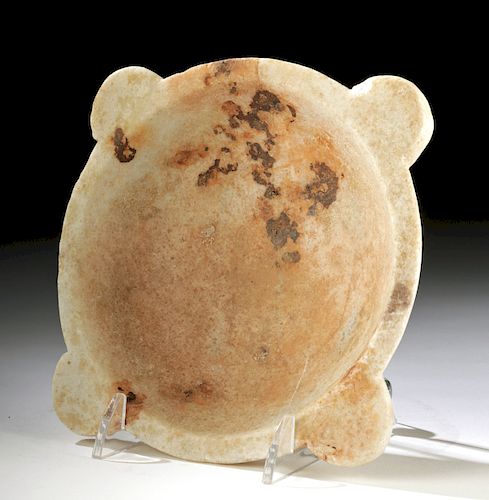Rare Egyptian Old Kingdom Alabaster Offering Dish
Lot 15
About Seller
Artemis Fine Arts
686 S Taylor Ave, Ste 106
Louisville, CO 80027
United States
Selling antiquities, ancient and ethnographic art online since 1993, Artemis Gallery specializes in Classical Antiquities (Egyptian, Greek, Roman, Near Eastern), Asian, Pre-Columbian, African / Tribal / Oceanographic art. Our extensive inventory includes pottery, stone, metal, wood, glass and textil...Read more
Categories
Estimate:
$2,000 - $3,000
Absentee vs Live bid
Two ways to bid:
- Leave a max absentee bid and the platform will bid on your behalf up to your maximum bid during the live auction.
- Bid live during the auction and your bids will be submitted real-time to the auctioneer.
Bid Increments
| Price | Bid Increment |
|---|---|
| $0 | $25 |
| $300 | $50 |
| $1,000 | $100 |
| $2,000 | $250 |
| $5,000 | $500 |
| $10,000 | $1,000 |
| $20,000 | $2,500 |
| $50,000 | $5,000 |
| $100,000 | $10,000 |
| $200,000 | $20,000 |
About Auction
By Artemis Fine Arts
Sep 26, 2019
Set Reminder
2019-09-26 10:00:00
2019-09-26 10:00:00
America/New_York
Bidsquare
Bidsquare : Exceptional Day 1: Antiquities & Asian Art
https://www.bidsquare.com/auctions/artemis-gallery/exceptional-day-1-antiquities-asian-art-4437
Day 1 of an important 2-day auction featuring exceptional, museum-worthy examples of Egyptian, Greek, Etruscan, Roman, Viking, Russian, Near Eastern, as well as Asian Art from China, Japan, Thailand, Vietnam, Burma and India. Artemis Fine Arts info@artemisfinearts.com
Day 1 of an important 2-day auction featuring exceptional, museum-worthy examples of Egyptian, Greek, Etruscan, Roman, Viking, Russian, Near Eastern, as well as Asian Art from China, Japan, Thailand, Vietnam, Burma and India. Artemis Fine Arts info@artemisfinearts.com
- Lot Description
Ancient Egypt, Old Kingdom, 3rd to 6th Dynasty, ca. 2686 to 2181 BCE. A hand-carved banded alabaster bowl with a thick circular base, gradually-expanding walls, a rounded rim, and a shallow basin with a recessed central cavity. Four flat half circles project from the sides of the rim, giving the bowl a squared-off profile. The stone of this example glows warmly in the light; deposits on it indicate that it had something with a high iron content placed near it during its time buried. Size: 6.75" W x 1.4" H (17.1 cm x 3.6 cm)
Alabaster was quarried along the length of the Nile, from Giza to just south of Luxor. Offering bowls like these were used in temples and placed in the tombs of people at all class levels. For example, Auguste Mariette, the famous French Egyptologist of the 19th century, found a cemetery for the poor in Memphis where the dead had been buried without wrappings only three feet below the ground; however, each had a small alabaster bowl and some animal bones, as they had been given food and drink for the afterlife. Meanwhile, kings were buried with many vessels, often of the highest quality. These vessels were necessary to provide for the dead during their time in the underworld.
Provenance: private East Coast, USA collection; ex-California, USA private collection, 1980s
All items legal to buy/sell under U.S. Statute covering cultural patrimony Code 2600, CHAPTER 14, and are guaranteed to be as described or your money back.
A Certificate of Authenticity will accompany all winning bids.
We ship worldwide and handle all shipping in-house for your convenience.
#142894Intact, with light scratches, chips, and nicks commensurate with age. Beautiful deposits on surface.Condition
- Shipping Info
-
All shipping is handled in-house for your convenience. Your invoice from Artemis Gallery will include shipping calculation instructions. If in doubt, please inquire BEFORE bidding for estimated shipping costs for individual items.
-
- Buyer's Premium



 EUR
EUR CAD
CAD AUD
AUD GBP
GBP MXN
MXN HKD
HKD CNY
CNY MYR
MYR SEK
SEK SGD
SGD CHF
CHF THB
THB














